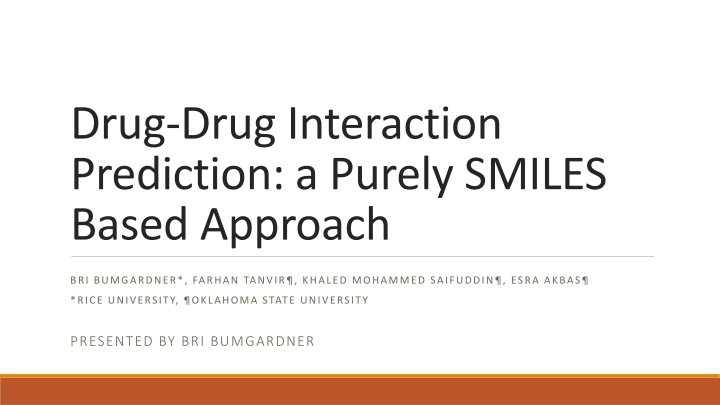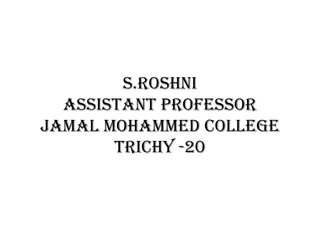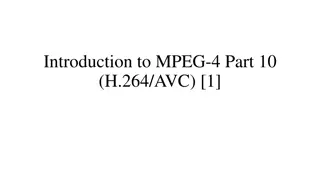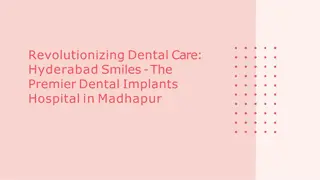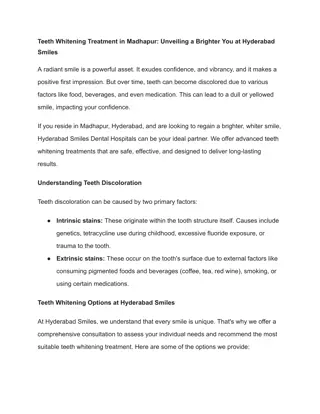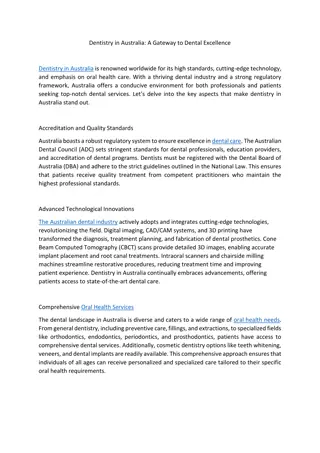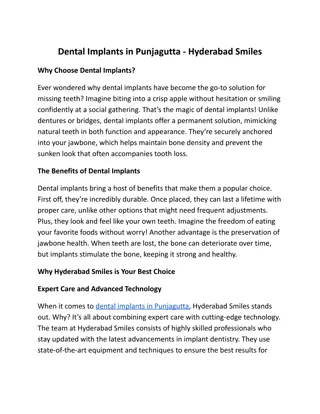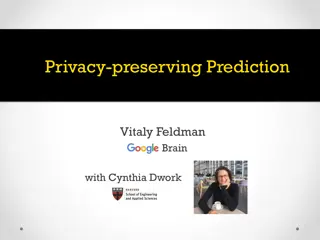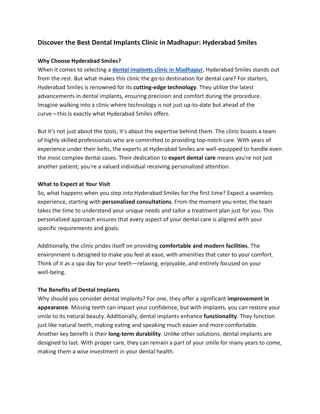Drug-Drug Interaction Prediction using SMILES: A Novel Approach
This research delves into predicting Drug-Drug Interactions (DDIs) solely based on SMILES strings, employing graph approaches and machine learning classifiers to generate features and make predictions. Extracting chemical substructures and utilizing node embeddings play a key role in this innovative methodology.
Download Presentation

Please find below an Image/Link to download the presentation.
The content on the website is provided AS IS for your information and personal use only. It may not be sold, licensed, or shared on other websites without obtaining consent from the author.If you encounter any issues during the download, it is possible that the publisher has removed the file from their server.
You are allowed to download the files provided on this website for personal or commercial use, subject to the condition that they are used lawfully. All files are the property of their respective owners.
The content on the website is provided AS IS for your information and personal use only. It may not be sold, licensed, or shared on other websites without obtaining consent from the author.
E N D
Presentation Transcript
Drug-Drug Interaction Prediction: a Purely SMILES Based Approach BRI BUMGARDNER*, FARHAN TANVIR , KHALED MOHAMMED SAIFUDDIN , ESRA AKBAS *RICE UNIVERSITY, OKLAHOMA STATE UNIVERSITY PRESENTED BY BRI BUMGARDNER
Drug-Drug-Interactions (DDI) What & Why? Abstract Our Research SMILES strings (Simplified Molecular Input Line-Entry System) Extract chemical substructures Graph approach GNN to generate node embeddings Concatenate to generate DDIs features Use ML classifiers for DDI prediction
Related Work Methodology Constructing Graph Drug Representation Learning Creating DDI representations ML with DDI Representations Results Conclusion Q&A Brief Overview
Similarity-based: Abdelaziz et al., Large-scale structural and textual similarity-based mining of knowledge graph to predict drug-drug interactions , 2017. Classification-based: B. Davazdahemami and D. Delen, A chronological pharmacovigilance network analytics approach for predicting adverse drug events, 2018. Zheng et. al., DDI-PULearn: a positive-unlabeled learning method for large-scale prediction of drug-drug interactions , 2019 NN-based: M. Zitnik, M. Agrawal, and J. Leskovec, Modeling polypharmacy side effects with graph convolutional networks, Bioinform., 2018 Related Work
1. Constructing the graph using SMILES strings Methodology: Broad Overview 2. Drug representation learning from the graph 3. Creating DDI representation 4. Machine Learning with DDI features
Key Ideas Only SMILES information of drugs utilized. 1: Create Graph Using SMILES Strings Mine the frequent substructures using ESPF algorithm by Huang et. Al. (Explainable substructure partition fingerprint). Create graph: nodes are drugs, edges drawn between drugs that share a predetermined number of substuctures (S-Value).
ESPF Algorithm L. G. J. S. Kexin Huang, Cao Xiao, 2019.
Example of partitioning using ESPF
Graph Details 1. Drugs used for this paper taken from DrugBank: FDA approved DrugBank Data included SMILES strings & at least one DDI with another drug. Some numbers: 824 drugs total in our dataset with 96,751 known positive interactions. For ESPF algorithm, we set a freq of 5 occurrences. After running ESPF, a total of 741 unique substructures found. Several S-Values used: 2, 3, and 4.
Graph Details 2. The Graph is weighted with the number of substructures the two nodes share.
For each S-Value, use GNNs on our Graph(s) to generate node embeddings. Graphsage (GS) Graph Convolution Network (GCN) Graph Attention Network (GAT) 2: Drug representation learning from the Graph For each GNN, two-layer architecture with learning rate, batch size and epochs set to 0.7, 20 and 5, respectively. Embeddings generated are all 128 bits long.
96, 751 positive interactions given by DrugBank. Random Selection to generate negative interactions. Concatenate embeddings from the two drugs involved for each of the positive and negative interactions. Add a labeling bit 0/1 to indicate the type. 3: Creatingthe DDI representations Each DDI represented by a vector of size 257.
Baseline Feature Vector Creation To compare to the results of our feature vectors, we also create baseline vectors using the method outlined in Huang et al. s 2020 paper Caster: Predicting drug interactions with chemical substructure representation. Since we have a total of 741 unique substructures, these representations are of size 742.
Binary Classification ML models to learn from the DDI vectors: 4: Machine Learning with DDI features K-Nearest Neighbors Logarithmic Regression Feed forward Neural Network 70% - 30% Train/Test split of the DDI data Parameters: K = 5 for KNN 100 Epochs for NN
For each combination of the three GNN models and each of the three S-Values, we trained the three mentioned ML models with 70% of our DDI vectors Results Each trained model used to classify the remaining 30% of the data. Performance measured using standard methods Accuracy, Precision, Recall and F1-score.
An S-Value of 2 gave the best accuracy across all ML models and embeddings.
Closer look at GraphSage as highest performing embedding model.
Chemical substructures are critical for DDI prediction Frequent chemical substructure -> graph superior to similarity measures. Strong evidence that a method that only relies on the readily available SMILES string information of drugs is viable. Conclusions For future work: Extend our model to predict exact side effect(s) caused by DDIs. Improve negative pair selection by learning from known non- interacting pairs to generate a set of negative DDIs Creation of hypergraph from our substructures and using HyperGraph Nueral Network Learning.
Acknowledgements Dr. Thanh Thieu, for encouraging me to apply for this REU opportunity. Dr. Esra Akbas, both for her mentorship and encouragement as well as for this amazing opportunity to work in her lab over last summer during my REU at Oklahoma State University. Farhan Tanvir, who was a huge source of help to me both during my research and writing this paper. Khaled Mohammed Saifuddin, who also helped me write this paper and shared valuable insight on the more technical aspects. The Research Experience for Undergraduates (REU) program through the National Science Foundation grant no. 2050978 for funding this research project.
References I. Abdelaziz, A. Fokoue, O. Hassanzadeh, P. Zhang, and M. Sadoghi, Large-scale structural and textual similarity- based mining of knowledge graphto predict drug-drug interactions, J. Web Semant., vol. 44, pp. 104 117, 2017. B. Davazdahemami and D. Delen, A chronological pharmacovigilance network analytics approach for predicting adverse drug events, Journal of the American Medical Informatics Association, vol. 25, p. 1311 1321, 2018. Y. Zheng, H. Peng, X. Zhang, Z. Zhao, X. Gao, and J. Li, Ddi-pulearn: a positive-unlabeled learning method for large- scale prediction of drug-drug interactions, BMC Bioinformatics, vol. 20, 2019. M. Zitnik, M. Agrawal, and J. Leskovec, Modeling polypharmacy side effects with graph convolutional networks, Bioinform., vol. 34, no. 13, pp. i457 i466, 2018. [Online]. Available: https://doi.org/10.1093/bioinformatics/bty294 L. G. J. S. Kexin Huang, Cao Xiao, Explainable substructure partition fingerprint for protein, drug, and more, NeurIPS Learning Meaningful Representation of Life Workshop, 2019. K. Huang, C. Xiao, T. N. Hoang, L. Glass, and J. Sun, Caster: Predicting drug interactions with chemical substructure representation, in AAAI, 2020.
